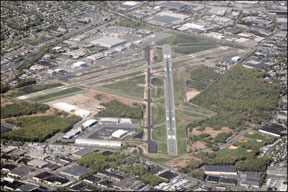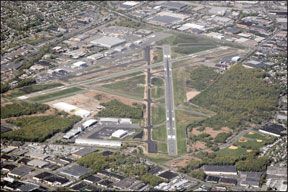You are a skilled, proficient and responsible pilot. You do everything in your power to avoid dangerous situations but there are a few unavoidable moments during each flight where, if the unthinkable happened, youd be left with few options. Flying is, after all, an exercise in risk management, not risk elimination. Imagine that youre departing from Mega City Municipal. With a healthy climb rate 288 established, you tuck away the landing gear, set climb power and prepare to enter the soup. Just as the airport fence slides underneath the belly, your sole engine shivers and goes silent. Youre only 500 feet above the ground, so turning back to the runway is not a reasonable option. You look out the window and all you see is a patchwork of gray and black boxes. Can you land on that stuff? The answer depends on what exactly “that” is. Heres where a little homework could save your bacon. Fly The Airplane The FAA ensures that you have at least one obstacle-free way of getting into and out of any given airport, but has little to say about what types of low-lying structures lie below the flight path. Many airports are surrounded by warehouses or industrial property, because community zoning boards and airport managers generally agree that most people dont want to live near an airport. The good news-if we can find a silver lining here-is that you are more likely to find yourself over some sort of industrial property at 500 feet agl with a dead engine, not a neighborhood packed with people. So, there you are. What are you going to do? First, you need to calm down, slow down and fly your airplane. In his article titled “Turnbacks Reconsidered” (
“A shallow impact angle and low speed affords the airplanes occupants the greatest measures of time and distance within which that energy is dissipated,” Stowell wrote. “Survivability does not depend on where the crash occurs, but rather how the crash occurs. Contacting obstacles and terrain-trees, water, buildings, parking lots, ball fields-while low and slow, in the landing attitude and with at least some distance over which the airplane can decelerate all significantly increase the chances of survival.”
So there is at least some chance that you will walk away from a landing on something other than a cow pasture or a runway but, when faced with non-traditional landing surfaces in an emergency, are some more survivable than others?
Up On The Roof
Allyn Kilsheimer, CEO of KCE Structural Engineers, P.C. in Washington, D.C., said that it might be possible for a small aircraft to land on the roof of a warehouse building, but it would have to be a very soft touchdown, and theres no guarantee the aircraft would stay put for long.
“Most roofs are designed to support 30 pounds per square foot,” said Kilsheimer, who played a key role in the analysis and rebuilding efforts at the Pentagon following the September 11, 2001, terrorist attacks. Elevated automobile parking decks are designed to support about 80 pounds per square foot, he said, but a 3000-pound airplane will impose much more load than that once it settles to the ground.
“When you put the weight on two points, its possible that [the plane] could roll and then the tires could punch through the deck,” Kilsheimer said. Still, punching through a warehouse roof at low or no forward speed is far preferable to taking ones chances by, say, landing on a tree-lined residential street.
Speed Kills
The key would seem to be getting the plane as slow as possible without stalling, holding it in ground effect until it settles to the surface, and to keep flying it all the way through the touchdown and obstacle-riddled rollout. Do your best to steer in between things like HVAC structures and antennas that are frequently mounted on the roofs of industrial buildings.
If you are one of those pilots who tacks on “a few knots for the wife and kids” you might want to get out there and practice full-stall landings, because in a real off-airport landing, any extra speed you are carrying at touchdown is energy that will have to be absorbed by something, including your own body.
Whether or not you survive such an arrival will depend partly on your approach and partly on luck, because you have no way of knowing how sturdy that rooftop really is. But if youre faced with a choice between landing on a warehouse and plowing into, say, an oil tank farm, common sense dictates you should take your chances with the warehouse.
Plan Ahead
This may also illustrate a valid reason for avoiding an intersection departure from a runway that launches you out over buildings and power lines. Sure, your little airplane can get up and away in half the available runway length, and an intersection departure might be more convenient to your FBO of choice, or make the tower controllers life easier. But if the engine fails to perform during those first few seconds of flight, wouldnt it be nice to have a mile of pavement ahead of you, or at the very least, the option of turning slightly right or left and landing on an intersecting runway or taxiway?
The satellite imagery available on the Google Maps Web site,
maps.google.com, is an excellent resource for pilots traveling to unfamiliar airports, because it lets you see exactly what youll be dealing with before you even leave home. Simply type the name of the airport into the search box and, when the map appears, click on the link that says “Satellite.”While there is no way to know for sure exactly when the image was generated, you should be able to get a pretty good idea of how closely the neighbors have encroached upon the airport and its traffic pattern, and what types of structures exist there. If you zoom in and notice a big patch of dirt near developed property, dont assume the patch is still vacant. Call the airport manager and ask.
Shopping mall or office complex parking lots can and have been used for emergency landings, but watch out for light poles, concrete barriers and parked vehicles. According to the NTSB, on October 3, 2006, a Beech 36 landed in a parking lot in Centennial, Colo., after the aircraft lost power on final approach to the airport. During the forced landing the airplane impacted a light pole and three parked vehicles, but the pilot sustained only minor injuries.
Handbook Exercises
How many feet will your airplane need to come to a stop once you touch down? Is that parking lot big enough? Heres another way Google can be a useful tool. Log on and take a look at the area around your airport of choice, locating a nearby parking lot. Notice that the satellite display, as well as the regular map display, offers a distance scale. If you zoom in enough, the scale will be calibrated to as little as 50 feet.
Take a look at the Palisades Center in West Nyack, N.Y., for example. This shopping mall is located adjacent to Interstate 287 about 12 miles northwest of the Westchester County Airport (HPN) in White Plains, New York. Ive flown directly over the mall on several occasions while being vectored for a visual approach into HPN. The malls parking lot is the last relatively open, flat, paved surface, not including the Interstate (see the sidebar on page 14), before crossing the Hudson River inbound to the airport.
Lets pretend you are over the mall at about 1500 feet agl on a vector to land on Runway 16 at White Plains when things get quiet. With gusty southerly winds, youre unable to glide to the golf driving range located about a half a mile to the south of the mall. Your options to the north include a rock quarry, a lake and trees. It looks like the parking lot is your best shot.
The satellite view of the mall shows large parking areas on both the north and south sides of the mall. Based on the scale, it would appear that the longest stretch of potentially obstruction-free pavement in the south lot is about 2000 feet long and 50-100 feet wide-enough room to land many light single-engine aircraft, if proper technique and airspeed are used.
However, note that the rows of parking spaces run perpendicular to the longest stretch of the lot, creating possible hazards from objects like concrete barriers or shopping carts. Landing in between rows of cars would provide approximately 1000 feet to stop with about 25-30 feet in between the parked cars-again, probably enough room to land a light single-engine airplane and slow down enough to prevent killing yourself.
But then there are the shoppers getting into and out of their cars. You probably want to avoid them, so the more humane choice would probably be to land across the rows on the edge of the lot and hope you dont hit anything. If its a busy weekend shopping day, youre probably out of luck there.
The suburban areas where most GA airports in metropolitan areas are found can be daunting places to confront the need for an off-airport landing. This is especially true right after takeoff when altitude, airspeed and choices are in short supply.
In situations like this, pilots must accept the airplane is likely to suffer some damage before it comes to a stop. The keys to walking away involve maintaining control, touching down at the lowest possible airspeed and choosing your landing area wisely. Some pre-flight research of the area surrounding your airport, along with a little luck, wont hurt a thing.
Meredith Saini is a freelance aviation writer and flight instructor flying from the Gaithersburg, Md., area.




